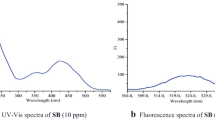Abstract
The development of sensors for selective detection of cyanide ion (CN−) is an important mission to accomplish because of the versatility and toxicity of CN−. In the present work, an “ensemble”-based colorimetric and fluorescent sensor (L2-Zn2+) for CN− ion has been developed. The addition of cyanide ions removed Zn2+ from the ensemble (L2-Zn2+) in aqueous medium, resulting in a color change of the solution from red to buff and a “turn-on” fluorescent response. Also, the sensitivity of both the fluorescence- and colorimetric-based assay is below the maximum allowable level of cyanide ions in drinking water set by the World Health Organization. In addition, test strips, which served as convenient and efficient CN− test kits, were fabricated based on the sensor. Notably, the selective detection of cyanide with L2-Zn2+ for practical application was also performed in sprouting potatoes.
Similar content being viewed by others
References
Jin C, Zhang M, Deng C, Guan Y, Gong J, Zhu D, Pan Y, Jiang J, Wang L. Tetrahedron Lett, 2013, 54: 796–801
Gale PA. Chem Soc Rev, 2010, 39: 3746–3771
Xu Z, Kim SK, Yoon J. Chem Soc Rev, 2010, 39: 1457–1466
Beer PD, Gale PA. Angew Chem, 2001, 113: 502–532
Yu G, Zhang Z, Han C, Xue M, Zhou Q, Huang F. Chem Commun, 2012, 48: 2958–2960
Steed JW. Chem Soc Rev, 2009, 38: 506–519
Baud FJ. Hum Exp Toxicol, 2007, 3: 191–201
Matsubara K, Akane A, Maseda C, Shiono H. Forensic Sci Int, 1990, 46: 203–208
Holland MA, Kozlowski LM. Clin Pharm, 1986, 5: 737–741
Gale PA. Acc Chem Res, 2006, 39: 465–475
Beer PD, Gale PA. Angew Chem Int Ed, 2001, 40: 486–516
Young C, Tidwell L, Anderson C. Cyanide: Social, Industrial, and Economic Aspects. Warrendale, PA: TMS, 2001. 175–194
Eisler R. Cyanide hazards to fish, wildlife, and invertebrates: a synoptic review. Biological Report. Laurel: Patuxent Wildlife Research Center, 1991
Vennesland B, Comm EE, Knownles CJ, Westly J, Wissing F. Cyanide in Biology. London: Academic Press, 1981
Shan D, Mousty C, Cosnier S. Anal Chem, 2004, 76: 178–183
Gorchev HG, Ozolins G. WHO guidelines for drinking-water quality. World Health Organization, 2004, 34: 104–108
El-Ballouli AO, Zhang Y, Barlow S, Marder SR, Al-Sayah MH, Kaafarani BR. Tetrahedron Lett, 2012, 53: 661–665
Lee DY, Singh N, Satyender A, Jang DO. Tetrahedron Lett, 2011, 52: 6919–6922
Li J, Wei W, Qi X, Zuo G, Fang J, Dong W. Senso Actuat B-Chem, 2016, 228: 330–334
Li J, Qi X, Wei W, Zuo G, Dong W. Sensor Actuat B-Chem, 2016, 232: 666–672
Kumari N, Jha S, Bhattacharya S. Chem Asian J, 2012, 7: 2805–2812
Yuan L, Lin W, Yang Y, Song J, Wang J. Org Lett, 2011, 13: 3730–3733
Jung KH, Lee KH. Anal Chem, 2015, 87: 9308–9314
Kaushik R, Ghosh A, Singh A, Gupta P, Mittal A, Jose DA. ACS Sens, 2016, 1: 1265–1271
Lou X, Zhang L, Qin J, Li Z. Chem Commun, 2008, 48: 5848–5850
You GR, Park GJ, Lee JJ, Kim C. Dalton Trans, 2015, 44: 233–237
Zhao Y, Liu Y, Wang Z, Xu W, Liu B, Su JH, Wu B, Yang XJ. Chem Commun, 2015, 51: 1237–1239
Wei TB, Li WT, Li Q, Su JX, Qu WJ, Lin Q, Yao H, Zhang YM. Tetrahedron Lett, 2016, 57: 2767–2771
Xu Q, Heo CH, Kim G, Lee HW, Kim HM, Yoon J. Angew Chem Int Ed, 2015, 54: 4890–4894
Wei TB, Li WT, Li Q, Qu WJ, Li H, Yan GT, Lin Q, Yao H, Zhang YM. RSC Adv, 2016, 6: 43832–43837
Shi BB, Zhang P, Wei TB, Yao H, Lin Q, Zhang YM. Chem Commun, 2013, 49: 7812–7814
Lin Q, Lu TT, Lou JC, Wu GY, Wei TB, Zhang YM. Chem Commun, 2015, 51: 12224–12227
Wu G, Shi B, Lin Q, Li H, Zhang Y, Yao H, Wei TB. RSC Adv, 2015, 5: 4958–4963
Wei TB, Zhang P, Shi BB, Chen P, Lin Q, Liu J, Zhang YM. Dyes Pigments, 2013, 97: 297–302
Yang L, Li X, Yang J, Qu Y, Hua J. ACS Appl Mater Interfaces, 2013, 5: 1317–1326
Zheng F, Zeng F, Yu C, Hou X, Wu S. Chem Eur J, 2013, 19: 936–942
Dong YM, Peng Y, Dong M, Wang YW. J Org Chem, 2011, 76: 6962–6966
Gabe Y, Urano Y, Kikuchi K, Kojima H, Nagano T. J Am Chem Soc, 2004, 126: 3357–3367
Acknowledgments
This work was supported by the National Natural Science Foundation of China (21662031, 21661028, 21574104, 21262032) and the Program for Changjiang Scholars and Innovative Research Team in University of Ministry of Education of China (IRT 15R56).
Author information
Authors and Affiliations
Corresponding author
Electronic supplementary material
Rights and permissions
About this article
Cite this article
Li, WT., Qu, WJ., Zhu, X. et al. A highly selective colorimetric and “Off-On” fluorescence sensor for CN− based on Zn(salphenazine) complex. Sci. China Chem. 60, 754–760 (2017). https://doi.org/10.1007/s11426-016-0438-4
Received:
Accepted:
Published:
Issue Date:
DOI: https://doi.org/10.1007/s11426-016-0438-4




